Netflix has made my life
better. Most of the movies and
television I watch now come from that vendor.
I can’t complain about their latest foray into the media market, Hemlock Grove.
HG is a series consisting of 13
episodes, all released at once. That is
very interesting. I have watched Breaking Bad, the first two seasons of Dexter and Sons of Anarchy, the same way: each episode when I found time to set
down and push play on the remote.
Netflix cut out the wait time.
HG has received very mediocre
reviews. I dissent. To be certain, it does not rank in the same
category as the aforementioned series. I
have only seen the first three episodes, but so far the acting, dialogue, and
story line fall well short of the Breaking
Bad level of genius. On the other
hand, the cinematography is top shelf.
The scenes of the fictional Pennsylvania town in fall colors are
breathtaking. Every face and movement is
alive with color and texture.
I have thoroughly enjoyed each
episode and I walk about craving for more.
I have not felt the slightest sense that the action is dragging, as many
critics complain. On the contrary, I
find the pace exquisite. Part of that is
simply that I like the characters. Landon
Liboiron as Peter Rumancek, a gypsy lad who goes postal during each full moon
is what I was in high school, except for the handsome, sexy, and werewolf
things. Bill Skarsgård as Roman Godfrey
is a sort of younger, handsomer Steve Buscemi.
It isn’t clear yet what Roman is, but he can do Jedi mind tricks at the
expense of the occasional nose bleed. He
has a straight out of Stephen King mom (Famke Janssen as Olivia Godfrey) who
seems to have her own pars, as we say
down south. She was Jean in the X
Men.
Meanwhile we have a couple of
refugees from Battlestar Galatica: Aaron
Douglas as Sheriff Tom Sworn and Kandyse McClure as Dr. Clementine Chausser. What’s not to like?
The first three episodes
already have given me one of the best werewolf kills and transformation scenes
that I can remember. The plot is rich
with promise, including a mad scientist and a possible alien connection. Again, what’s not to like?
I will post again when I have
digested the whole series. If you have
Netflix, get this series. You won’t be
disappointed. Here is one last image to draw you in.













